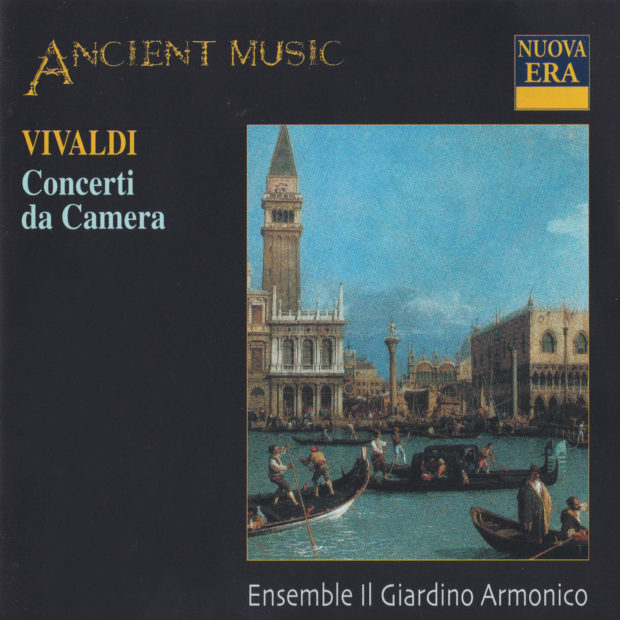“Brought up at the expense od the State, these girls are taught and instructed simply so that they may distinguish themselves in music. Thus they sing like angels and play the violin, the flute, the organ, the oboe, the cello, the bassoon; in short there is no instrument, however great it may be, that can daunt them.”
Thus wrote the French humanist and historian Charles de Brosses in 1739 in his Lettres Historiques et Critiques sur l’Italie, about the instrumental and vocal abilities of the girls who were brought up and educated in music in the Venetian Hospitals, institutes whose task it was to recover and look after orphans and abandoned children. It was for these girls that Antonio Vivaldi “Maestro de’ Concerti del Pio Ospedale della Pietà di Venezia” as he terms himself in the opera II (1709), wrote a great number of concertos, that were destined for celebrated public performances that excited so much the enthusiasm amongst travellers who arrived from all over Europe. Vivaldi was commisioned to keep producing new compositions for the “Pietà”, and this fact certainly encouraged him to explore and experiment varying and original solutions in the Concerto that took into consideration the avilability of a great number of performers who were experts even with unusual or, indeed, unknown instruments (a particular feature it seems of the members of the “Pietà”). And so he created Concerti which required the use of salm, of “violini in tromba marina”, of “viole all’ inglese” etc., searching for almost “experimental” juxtapositions of coloirs and sonority. It is in this spirit that we can include a group of concertos for a reduced number of players — between three and five real parts with no doubling up of instruments — that were known as “Concerti da Camera” (Chamber Concertos). This idea of placing together different instruments, two of three which were generally wind instruments, each with a solo, concertante function, was something original in the ambit of Italian instrumental music at that time which was dominated by string music deriving perhaps from the Venetian “Sonata Concertante”, that had been fashionable for more than half a century.
Most of these compositions included the use of the flute or the recorder and of the bassoon, instruments which did not have a great repertoire then and which Vivaldi himself raised to importance dedicating a great number of solo concertos to them. The manuscript scores are held in the Biblioteca Nazionale in Turin. The autograph copies are characterised by a rapidity and carelessness of hand, with enormous cancellations and “second thougths” that are indicative of Vivaldi’s modus componendi: a fury of composition, of which the composer himself was proud, claiming, according to De Brosses “that he could compose a concerto in all its parts faster than a copyist could copy it”. Thought they are similar in form and structure, these “Concerti da camera” possess differing characteristics. The G major concerto RV101 and the Tempesta di mare (Storm at Sea) RV98 are in fact real solo concertos for solo recorder and orchestra, here unusually made up of a dissimilar group of solists (oboe, violin, bassoon plus basso continuo). It is not by chance that these two compositions were later included, with the necessary changes, in a collection of six Concertos for flute and strings, op. 10, published in Amsterdam in 1728. In Vivaldi we often find movements that are used in more than one collection (a practice that he shared with other great XVII century composers like Bach, Handel and Telemann); for example the largo from the G major concerto which is identical to the second movement of Concerto VII of op.8 // Cimento dell’Armonia e dell’Invenzione and the Largo from the G minor Concerto RV107 that is fundamentally the same as the second movement in the Concerto for Oboe and Violin RV548. The last movement of the concerto in G major and the concerto in G minor RV107 — in third time — adopt the variation form, the formed based on he theme of the Largo that is reproposed in the major key, where the recorder alone exhibits itself in a virtuoso and almost humouristic series of variations, the latter on a Chaconne bass, where in turns, individually or in groups, the instruments share the parts equally, culminating in the finale in a sort of collective variation that has a splendid effect.
The Concerto for three RV103 for recorder, oboe and bassoon is particularly interesting, being a sort of miniature concerto in which the flute is soloist in the first movement, contrasting with the oboe entries, which together with the recorder and the bassoon make up the “tutti”. In the Largo, on the other hand, the melody is evenly shared between the flute and the oboe, with support from the bassoon, unlike the other slow movements which are generally led by the recorder. The some balance is found in the Allegro con moto, where the two solo instruments alternate in the exposition of an unusual chromatic theme. Finally the Sonata for recorder and bassoon, in the classic form of the Church Sonata in four movements, even though it is not a proper concerto, places the two instruments on an equal level, in a game of counterpoint and truly “concertante” dialogue, in the strictest sense of the word, that is to say “competition”, but also co-operation, in the context of great instrumental virtuosity, similar to the technical demands that Vivaldi makes of the two instruments in solo concertos.

